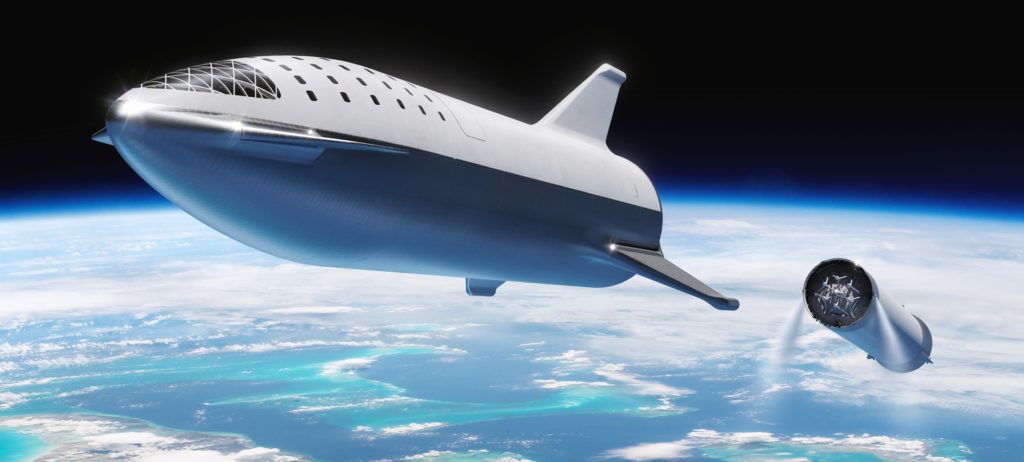In the latest entry of SpaceX’s ever-changing Starship design process, CEO Elon Musk has indicated that the nominally reusable orbital spacecraft has moved away from a liquid-cooled steel heat shield to something slightly more traditional.
This information came as a SpaceX engineer announced during Cargo Dragon’s CRS-18 webcast that the twice-flown spacecraft would mark the first orbital test of a ceramic heat shield tile meant for use on Starship’s windward side. This major design change comes as a significant surprise and seems likely to either delay Starship’s orbital debut or hinder its ultimate reusability, although Musk just as recently claimed that the spacecraft could reach orbit for the first time less than six months from now.
Testing a possible Starship windward side ceramic tile. Maximizing emissivity is best for conductive/particle heating. Nice thing about steel is that tiles can be very thin, unlike carbon fiber or aluminum airframe.
— ln(e) (@elonmusk) July 25, 2019
Thin tiles on windward side of ship & nothing on leeward or anywhere on booster looks like lightest option
— ln(e) (@elonmusk) July 25, 2019
Back in late-2018 and early-2019, Musk took to Twitter to announce that SpaceX was pursuing an exotic metallic heat shield that would be cooled in large part by flowing liquid methane through tiny holes on its exterior, effectively ‘sweating’ away energy and preventing steel tiles from melting.
Despite incontrovertible evidence that SpaceX performed some amount of significant testing on the hexagonally-tiled steel heat shield concept, Musk’s July 24th tweets indicate that the liquid-cooled heat shield is unlikely to ever be used on Starship. For unknown reasons, SpaceX is instead pursuing some sort of thin ceramic heat shielding to protect the entirety of Starship’s windward side (i.e. the side facing the atmosphere during reentry). A handful of the first flight-qualified ceramic tiles – shaped for Dragon instead of Starship – will be tested on Cargo Dragon during the spacecraft’s orbital mission and eventual reentry.
Of note, this is not the only major design change Starship has undergone in just the last few months. Speaking on May 30th, Elon Musk stated that the design of Starship’s landing legs/fins and actuating wings and flaps has changed significantly since SpaceX revealed the new tripod fins + canard wings configuration in September 2018. According to Musk, that change will (or at least should) not significantly impact Starship’s schedule.

In fact, per his July 2019 claims that the first full-fidelity Starship prototype(s) could begin test flights in September/October and reach orbit as early as December/January, the Starship/Super Heavy schedule has actually radically sped up in the first half of 2019. In December 2018, Musk stated that he believed Starship had a 60% chance of reaching orbit in 2020, let alone late-2019.
For Starship, the massive spacecraft’s heat shield is arguably its single most important component. A failure to ensure that the heat shield is unprecedentedly reusable and reliable – even in the face of ultra-high-velocity interplanetary reentries – will severely limit Starship’s ability to achieve its ultimate goals of enabling affordable access to space and building a sustainable city on Mars. Musk’s comment that ceramic tiles are just “a possible” Starship heat shield element further indicates that SpaceX has yet to firmly settle on a heat shield design, let alone qualify said shield for orbital flight or kick off the mass-production necessary to completely cover multiple Starship halves.

Admittedly, there is still some good news in this unfortunate development. Most notably, the fact that Starship will still be made of steel means that the non-metallic heat shield tiles can be extremely thin and light, as they can be more or less directly attached to Starship’s steel hull. Additionally, steel Super Heavy boosters may be able to get away with zero heat shielding thanks to the relatively high melting point and heat resistance of certain varieties of stainless steel.
So long as both of those characteristics remain true, it’s likely that it will still make sense for Starship/Super Heavy to be built entirely out of steel instead of something like aluminum or carbon composite. With any luck, Elon Musk will provide a detailed update on the status of SpaceX’s next-generation launch vehicle soon after Starhopper survives its first untethered flight test.
Check out Teslarati’s newsletters for prompt updates, on-the-ground perspectives, and unique glimpses of SpaceX’s rocket launch and recovery processes.

<!–
–>
var disqus_shortname = «teslarati»;
var disqus_title = «SpaceX CEO Elon Musk hints that Starship’s ’sweating› metal heat shield is no more»;
var disqus_url = «https://www.teslarati.com/spacex-elon-musk-nixes-starship-sweating-heat-shield/»;
var disqus_identifier = «teslarati-110056»;

